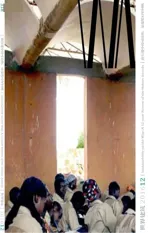阳光、风和水
2016-12-21张弦
阳光、风和水
Sun, Wind and Water
弗朗西斯·凯雷18岁的时候从布基纳法索到柏林学习建筑。如今他在非洲的老家和欧洲的新家两个世界之间穿梭。为了建立起两种文化之间的桥梁,他花了数十年的时间在他的家乡培养人们对教育价值的重视。通过与当地社区的合作,他已经成为一个中学项目背后的驱动力。
冈多3000人左右的居民居住得比较分散;新的中学也为他们提供了一个新的城市中心。布基纳法索几乎一半的人口年龄在16岁以下,这就使良好的教育机会显得尤为重要。
有一些在豪瑞奖比赛中获奖的项目是由公共部门组织的,其他是由那些富有想象力的团队在主导,剩下的则是一些个人的想法——就像2012年全球豪瑞奖金奖的获奖项目。如果没有迪埃贝多·弗朗西斯·凯雷(生于 1965 年),那么布基纳法索的中学项目就根本不会存在。虽然这个项目是很多人努力的结果,而弗朗西斯·凯雷也不是一个爱出风头的人,但有一点是毋庸置疑的:他是冈多的学校之父。他就像一个好父亲一样尽心尽力地工作,以确保孩子们会健康成长直至有一天能自立。
官二代也无特权
弗朗西斯·凯雷说:“我希望能够帮助我的村庄得到发展。但我也希望社区得到的不仅仅是金钱。”
弗朗西斯·凯雷在非洲西部的老家布基纳法索位于南部炎热的萨赫勒地带。该国是世界上最贫穷的国家之一,但是政治环境却相对稳定。1700 万居民中有3/4都生活在农村地区。弗朗西斯·凯雷也是这其中的一员。他是冈多村长的长子。冈多位于首都瓦加杜古以南约200km。凯雷强调,他的父亲是村长并不意味着他有任何特权。“相反地,这种身份是一个沉重的负担。村长的儿子不仅没有任何正式的权力,也不会带来额外的收入。”凯雷被送去上学的原因是为了保证在家庭中至少有一个人能够认字和写字,在这之前他父亲收到任何的信件都不得不由一位政府官员大声宣读。决定送他去学校是非常重要的一步。在布基纳法索,甚至连小学教育也不一定能保证。因为很多孩子们在农田里干活而不去上学,这样带来的结果就是布基纳法索只有1/4的成年人识字。凯雷很好地利用了这个提供给他的机会。他在学校里表现非常出色,因而被推选到省会的一所职业学校继续求学。接受完木匠和细木工训练后,他开始在首都寻找属于自己的一份工作。他告诉我们:“在那儿我得知德国提供一个大学奖学金的机会。我申请了,然后被录取了!”当时他刚满18岁,还不会说一句德语。“这简直令人难以置信。第一次坐飞机离开自己祖国也是令人难忘的:在空中俯视时,我看到世界变得越来越绿,然后突然有这样一大片的水——这是我完全无法想象的。”
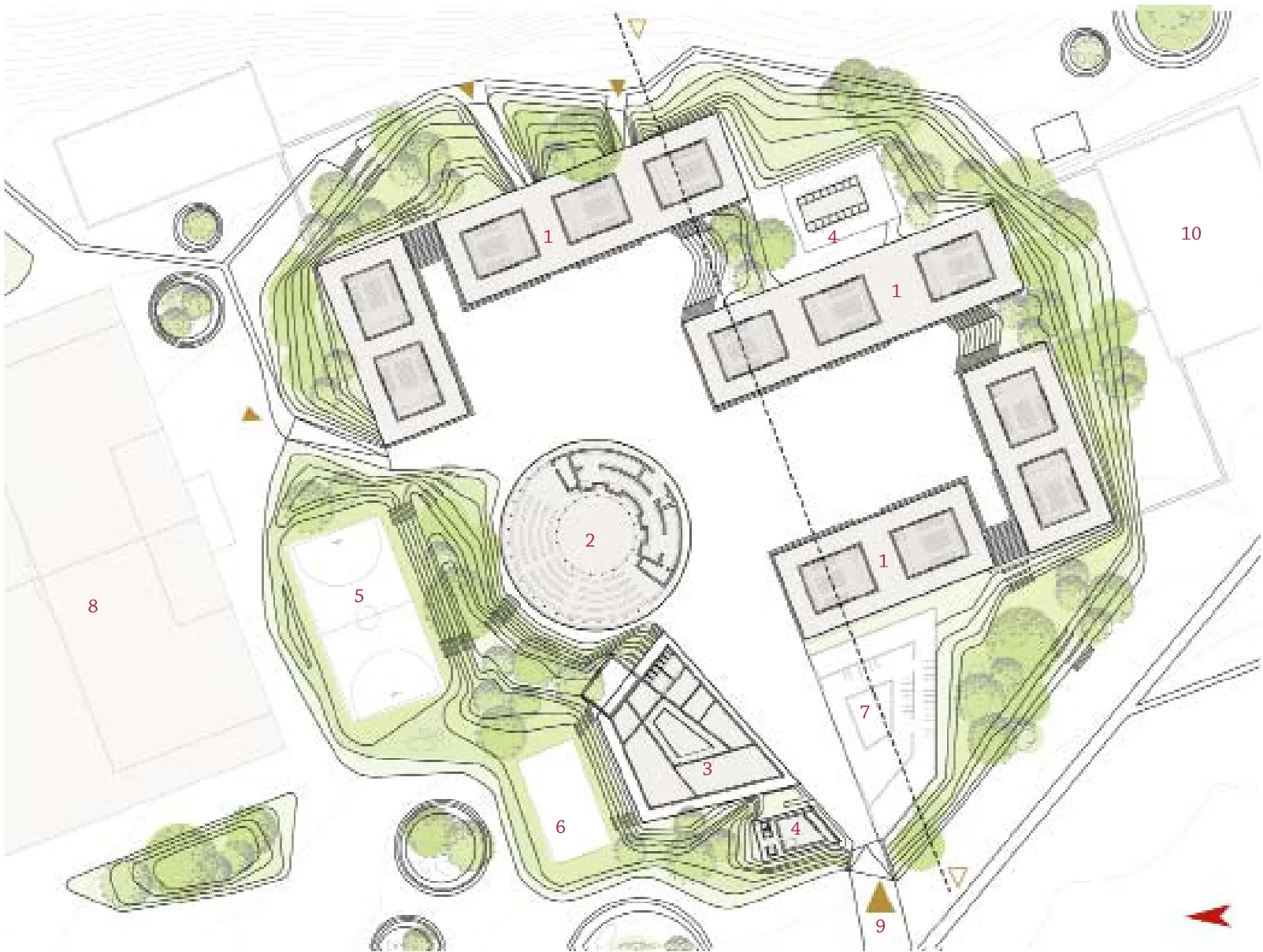
2 平面/Plan
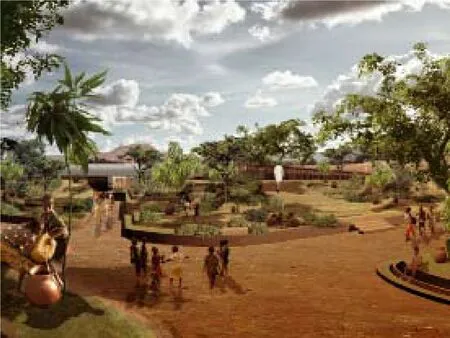
3 入口透视/Entrance perspective
授人以渔
非洲传统文化中,每个人都必须照顾他的家人以及所在社区的其他成员。凯雷解释说:“如果一个人离开他的社区去寻求更好的生活,那么他就会试图通过提供财政支持来弥补他离开所留下的空缺。”所以人们都期待着像他这样的人能够为改善乡村居住条件做出贡献。“任何像我一样的人都会这么做的。我希望能够帮助我的村庄得到发展。但我也希望社区得到的不仅仅是金钱。”在欧洲,他意识到教育对于社会和经济发展是何等的重要。
“这就是为什么我想要在我的村庄建立一所好的学校,让尽可能多的儿童能够接受教育。这种小型项目可以在其他方面提升生活质量。”一开始他就清楚,所有项目长期来说都必须由村庄自己来运营,因此他坚持“授人以渔”。“我并不反对给饥饿的人一顿饭和食品援助,”他说,“事实上,在自然灾害后帮助受害者生存下来是我们的责任。但说实话,可持续的发展援助应该优先考虑。我们必须试着‘授人以渔,而不只是授人以鱼’。”
无上的荣耀
建筑师知道这所在冈多的旧学校被严重忽视,已处于崩溃边缘。他想要建造一座新的房子来取代它。他用了最直接的办法来给他的项目融资:作为柏林工业大学的一名建筑系学生,他说服了他的同学少抽几根香烟,省下钱去为学校买一两块砖,换句话说就是为冈多捐出几个硬币。这项运动获得了巨大的成功。当凯雷说他可以动员和鼓励其他人的时候,你几乎立刻就会相信他。
他和他的朋友在1998年创立了一个叫做“为冈多学校捐砖”的组织来为项目融资。这座造价约€30,000的建筑于2001年落成。
弗朗西斯·凯雷是以可持续发展和当地的传统、材料特性为指导原则。由于土墙的厚度,通风开口,以及超级大的屋顶,小学建成以后环境气候宜人。政府安排了老师以后,学校马上就来了很多学生。忽然之间每个人都在谈论它。在2004年学校获得阿卡汗奖,这在伊斯兰世界中是最重要的建筑奖。随后项目还陆续获得了多个奖项。在 2007 年项目获得奥德堡可持续建筑奖,在 2009年获得全球可持续发展建筑奖,以及在2010 年获得瑞士BSI建筑奖。尽管获得了这么多的荣誉,凯雷却没有沉溺在他的成功里面。2007 年他完成了冈多的教室住宅楼,并于2008年完成了小学的扩建项目。如今,一座公共图书馆和妇女中心也正在建设当中。
泥土很好
弗朗西斯·凯雷在他冈多所有的项目中都遵循着可持续发展的基本原则。在很大程度上,村庄的居民都参与了项目建设和社区发展。因此,居民很快就建立了对项目的认同感,还学习到了新的工作技能。“泥土往往被视为一种穷人才使用的建筑材料,”建筑师

4 总平面/Site plan

5 项目阶段/Project phases
At the age of 18, Francis Kéré moved from Burkina Faso to Berlin to study architecture. Today he commutes between two worlds: his original home in Africa and his new home in Europe.
As a bridge builder between the two cultures, he has spent more than a decade cultivating an awareness of the value of education in his native village where, in collaboration with the local community, he has been the driving force behind a school complex.
The 3000 or so inhabitants of Gando live in scattered settlements; the new secondary school provides a new center for them. Almost half of Burkina Faso's population is under 16 years of age – which makes it all the more important to provide good educational opportunities.
Some of the projects awarded prizes in the Holcim Awards competition are organized by public authorities. Others are initiatives of imaginative teams. And yet others are the inspiration of a single person – like the Global Holcim Awards Gold 2012 winning project. Without Diébédo Francis Kéré, born in 1965, the prizewinning school complex in Burkina Faso would not exist. Although the project is the result of the efforts of many people – and Francis Kéré not a person to hog the limelight – one point is undisputed: he is the father of the school in Gando. And like a good father, he works passionately to ensure that his child flourishes, grows bigger, and will one day be independent.
Headman's son without privileges
Francis Kéré's homeland Burkina Faso in West Africa is located in a very hot part of the southern Sahel zone. Te country is one of the poorest in the world, but politically stable. Tree quarters of its 17 million inhabitants live in rural areas. Francis Kéré, too, is one of this majority, the eldest son of the headman of Gando, a village about 200 kilometers south of the capital Ouagadougou. The fact that his father was the headman does not mean that he was privileged, the architect emphasizes. "On the contrary, it is a heavy burden to be the headman's son. Tis duty no longer has any formal power, nor does it generate income." Francis was sent to school so that at least one person in the family would be able to read and write; up until then any letters that his father received had to be read out aloud by a government official. The decision to send him to school was an enormous step. In Burkina Faso even primary education cannot be taken for granted. Because many children have to work in the fields, they do not attend school, the outcome of which is that only one in four adults in Burkina Faso is literate. Francis made the best of the opportunity offered him. He was such a good pupil that he was selected for a vocational school in the provincial capital. After training as a carpenter and joiner he set out for the capital to look for a job. "Tere," he tells us, "I learned that Germany was offering a university scholarship. I applied – and got it!" At the time he had just turned 18 and did not speak a word of German. "It was simply mindboggling. To start with, the flight taking me away from my country was an unforgettable experience: looking down I saw the world get greener and greener, and suddenly there was this huge stretch of water – utterly inconceivable to me."

6 项目目标/Project objectives
Help for self-help
According to African tradition, each person has to care for other members of his family – and of his community, too. Kéré explains: "If a person leaves his community to seek a better life, he tries to make up for the gap he leaves by providing financial support." So it is expected of someone like himself that he will make a contribution to improve living conditions in the village. "Anyone in my position would act in the same way: I wanted to help to develop my village. But I wanted to offer the community more than just money." In Europe he realized how important education was for social and economic development.
"Tat is what motivated me to establish a good school in my village that would be attended by as many children as possible. Tis would be flanked by smaller development projects to help the standard of living in other ways." It was clear to him from the start that in the long term all projects would have to be run by the village itself; hence his insistence on "help for self-help." "I have nothing against giving hungry people a meal and food aid," he says. "Indeed, after a natural catastrophe it is our duty to help victims to survive. But in the case of honest, sustainable development aid other considerations have to take precedence. We have to try to teach people to fish rather than always give them fish."
Accolades galore
Te architect knew that the old school in Gando had been severely neglected and was in danger of collapsing, and he wanted to replace it with a new building. He took the most direct route to fund his评论道,“这也是为什么人们更喜欢昂贵的进口建材,然后却经常完全错误地来使用这些建材。”通过增强泥土强度,提供有创意的解决方案,凯雷想要让人们更能接受这种免费且取之不竭的天然建筑材料。冈多的学校项目培养了一批年轻人。他们学会了如何使用砖以及如何使用水泥等现代建筑材料。他们接受的训练可以帮助他们在村里找到工作从而减缓人口流失并给冈多的未来带来保障。弗朗西斯·凯雷指出:“我们在这里做的不仅仅是建筑或发展援助,这更是一个令人信服的社会事件。当妇女们在建造传统的泥土楼层时,男人们在用砖砌墙、扫走砾石、收集天然石材来做基础。”他们都想要为这座建筑做点什么以至于志愿者的数量经常会远远多于需要。志愿者的报酬就是每天一顿午饭,结果突然发现都没有足够的大米和豆子。很久以前,村庄居委会决定学校也将是他们的社区中心。他们在那里可以开会并进行疫苗接种。
农业的重要性
弗朗西斯·凯雷在冈多的目标之一就是重新造林。在他柏林工作室的时候他告诉我们:“我们还没有学会补种——我们总是以为,大自然自己会照顾自己。好长一段时间内确实没有什么问题,但近年来婴儿死亡率在该地区下降如此之快,实实在在的人口爆炸已经发生。自然资源正在以惊人的速度被消耗着,森林也正在被砍伐。在重新造林的早期,我们种植了很多桉树。这是一个严重的错误,现在我们才知道桉树会耗尽土壤的营养并使大自然变得贫瘠。“我讨厌这种东西,它们就跟长疯了似的,” 凯雷笑着说。他建议挑选较好的桉树木材进行建设,同时开始种植芒果树。总的来说,弗朗西斯·凯雷很重视农业。学校里学生和老师也耕作了一个菜园,这不仅可以为小学生们提供额外的食物来源,同时还结合了学术教育和实践活动。这是一种避免潜在错误的方法:“儿童以后仍然会干农活。学校没有让他们脱离传统,相反,他们还学到许多新的技能。”学校不仅没有断绝他们现有的道路,还为他们开辟了新的机遇。
两个世界之间的穿行者
由于在冈多设计了很多项目,弗朗西斯·凯雷在布基纳法索成了名人。越来越多的人来找他希望能得到他的帮助。这种期望值也给他带来了一定的压力。但他自己本身也给别人带来了压力:“社区要求居住在城镇和城市的人都向这个冈多的人学习。”弗朗西斯·凯雷的热情是能感染人的。他发现“作为一名建筑师生活非常艰难”。有时由于项目他一个月要飞到布基纳法索3次。直到最近他才成为柏林工业大学的一位助理因为他并不确定作为一名自由职业建筑师他是否能养活自己。在此期间,他是完全的自由职业者。目前他正在设计日内瓦国际红十字会博物馆的一部分。另一个引人注目的项目是Operndorf Afrika,这是他和已故德国导演克里斯托弗·施林格塞夫发起的布基纳法索的歌剧村。“我80%的工作是社会导向的,我做的很多项目都无法支撑我的生活消费。但我必须说,我从人们那儿得到的回报是无法用言语形容的。”
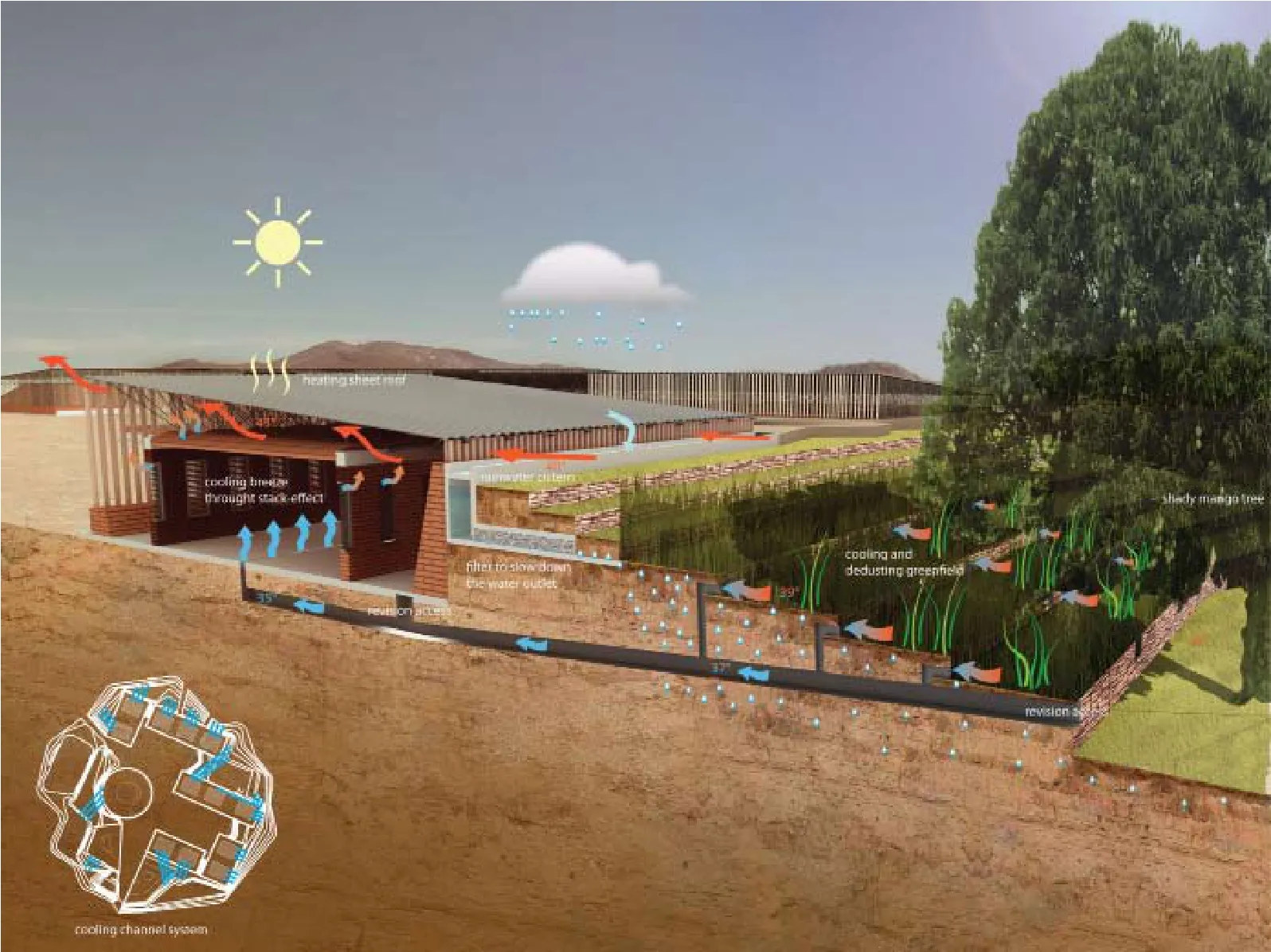
7 横剖面/Cross section
旅途继续
为此他继续不知疲倦在冈多工作。“起初我只想建立一个小小的小学学校,你只活一次,试问谁能够得到我现在这样的机会?”因为识字在布基纳法索的重要性,这里修了很多小学。但中学教育几乎被人遗忘。许多年轻人都只接受过小学的学校教育,因而没有资格寻求需要技能的职业。“但是一个国家需要好的技术人员,仅仅小学教育是不足够的。” 凯雷说道。所以,他现在正在冈多建造一所中学。他的设计为他赢得2011年中东非洲的豪瑞金奖和2012年的全球豪瑞金奖。从规模来说,这个项目在冈多是无可比拟的。项目占地3800m2,是2001年建成的那座小学的12倍, 而20万欧元的造价则是小学的几乎7倍之多。学校的5座大楼围绕中央庭院设计,12间教室可容纳600名学生,而学生也都来自更大的区域。建筑包含了凯雷和他的同事们迄今为止在冈多积累的所有经验,同时也包含了一系列的创新。凯雷说:“学校将成为一片绿洲,人们喜欢在那里学习。它也和布基纳法索其他地方破败的学校形成了鲜明对比”。房间都建在一个高台上面,屋顶的盖子也异常巨大,这可以保护刷过清漆的泥土承重墙。大量的泥土墙和天花板还可以防止阳光使教室升温太快。而山墙面的大开口则可以确保足够的通风。
“最重要的是这座建筑可以伫立不倒!”
弗朗西斯·凯雷觉得这些还远远不够。他说:“我希望能设计非常非常凉爽的房间”。因此,学校采用了一种巧妙特殊的冷却系统。教学楼的后墙堆了一部分人工土堆。土堆有植被覆盖,还有大芒果树遮阴。小土坡因为有地下蓄水池收集雨水,所以能经常保持湿润(布基纳法索有时会下很大的雨)。热风从开敞空间吹到凉爽的小土坡,在此过程当中被过滤和冷却。然后这些空气通过地下管道通向教室,并得到进一步的冷却。最后,在教室里它便成为凉爽而湿润的微风。吸力则是由倾斜的屋顶与天花板之间的空气运动而产生。空气被太阳加热、扩展并吹出。凯雷坚信,“这个系统能使室内温度比室外至少低6~8oC,而体感温度的差异还要更加明显。”冷却系统是将太阳能、 风能和热能统筹考虑而设计的。学校除了人工照明和计算机之外几乎没有使用任何电力。
最终项目将由太阳能电池板提供电力。弗朗西斯·凯雷长期以来就一直反对这种做法,因为村民们负担不起太阳能电池板,而学校也应该更多地展示当地科技。“然而,我们还未找到另一种选择”。否则学校采用的材料会尽可能的简单。学校的基座由花岗岩组成,屋顶是铁皮,结构则是轻型加固金属。不受欢迎的桉木也用在项目中。许多细节还有待决定。建筑师说他在冈多的工作就像他在工作室一样,大部分都是在场地上直接做决定。实用主义者认为,“这总是取决于当时有些什么。”他说他对可持续性本身并不感兴趣。“我从没想过我们现在开始来寻找一种真正智能的材料,我所想的是这种材料就在那里。我很喜欢将波纹钢和铁与其他材料一同使用。最主要的是,这座建筑物能伫立不倒,还可以被当地人民运营管理!”(张弦 译)project: as architecture student at the Technische Universit.t Berlin, he persuaded his fellow students to give up a few cigarettes and use the money saved to buy one or two symbolic bricks for the school, in other words to donate a few coins for Gando. Te campaign was a great success; you believe Kéré immediately when he states quite matter-of-factly: "I can mobilize and inspire people."
In 1998 he and friends founded an association, Schulbausteine für Gando (Bricks for the Gando School), which took charge of the project's funding. Te new building, which cost about EUR 30,000, was opened in 2001.
Irrigating the mango trees: clay vessels filled with water stand next to the plants, each with a small hole in the base, through which as much water as the plant needs constantly seeps. Te containers are filled by the pupils and teachers once a week.
Francis Kéré was guided by the principles of sustainable development and local traditions and materials. Thanks to thick earth walls, ventilation openings, and a roof with a large overhang, the primary school building has a pleasant ambient climate. The government provided teachers, the school filled with children immediately – and suddenly everybody was talking about it. In 2004 it received the Aga Khan Award for Architecture, the most important architecture prize in the Islamic world. This was followed in 2007 by the Zumtobel Award for Sustainable Architecture, in 2009 by the Global Award for Sustainable Architecture, and in 2010 by the BSI Swiss Architectural Award. Despite all this recognition, Kéré has not rested on his laurels – on the contrary. In 2007, the teachers' accommodation building in Gando was completed, and in 2008 the extension to the primary school. At present a public library and a women's center are under construction.
Earth is good
Francis Kéré applies fundamental principles of sustainable development in all his projects in Gando. The village community is heavily involved in the development process and in the construction work. As a result, the inhabitants quickly identify with the project – and learn new skills on the job. "Earth is often regarded as a building material for poor people," the architect comments, "which is why people prefer expensive imported building materials that are then often used utterly wrongly." By enhancing the earth and providing solid, constructive solutions, Kéré wants to raise acceptance of the free and inexhaustible natural building material. The Gando school project trains young people. They learn how to make bricks and how to work with modern building materials such as cement. Their training may also help them find work in the village, which will slow emigration and secure Gando's future. "What we are doing here is more than just architecture or development aid," Francis Kéré states. "It is a compelling social event. While the women produce the traditional earth floor, the men press the earth bricks for the walls, sweep the gravel, and collect natural stones for the foundation." All of them want to work on the building, and usually there are far more volunteers than needed. As payment, workers receive a meal at midday – "And suddenly there was not enough rice and beans." Long ago the village community decided their school would also be their community center, where meetings take place and vaccination programs are carried out.
The importance of agriculture
One of Francis Kéré's objectives in Gando is reforestation. In his studio in Berlin he tells us that "We haven't learned to replant – we always thought that nature would take care of things. And things were indeed fine for a long time. In recent years, though, infant mortality in the region has fallen so rapidly that a veritable population explosion has occurred. Natural resources are being consumed at a tremendous pace and the forests are being chopped down." Under early efforts at reforestation, eucalyptus trees were planted – a bad mistake and it is now known that they deplete the soil and impoverish nature. "I hate this stuff; it grows like crazy," Kéré says laughing. He proposes using the good eucalyptus wood for construction and planting mango trees instead. Francis Kéré attaches great importance to agriculture in general. Te pupils and teachers also cultivate a vegetable garden, which provides an additional source of food for the pupils and also combines academic education with practical activities. This is a way of avoiding potential mistakes: "Children will still be able to work as farmers later. The school has not removed them from their traditional structures; on the contrary, they have learned a lot of new skills." The school opens up new opportunities without shutting out existing ones.
A commuter between two worlds

8 气候概念/Climate concept
Owing to the diverse projects in Gando, Francis Kéré is a famous man in Burkina Faso. More and more people approach him with their concerns in the hope that he can help them. Tese expectations put a certain pressure on him. But he himself also puts pressure on others: "Communities aredemanding that many people now living in towns and cities should also act like this person in Gando." Francis Kéré's enthusiasm is infectious. He finds "life as an architect very tough." On occasion he flies to Burkina Faso three times a month on account of the projects. Until recently he was an assistant at the Technische Universit.t Berlin as he was not sure whether he could survive on his income as a freelance architect. In the meantime, he is completely self-employed. At present he is designing part of the Museum of the International Red Cross in Geneva. A high-profile initiative is Operndorf Afrika, the opera village in Burkina Faso that he and the late German director Christoph Schlingensief initiated. "But 80 percent of my work is socially oriented; a lot of the projects I do I can barely live on. But I must add: what I get back from people, you can't put that in words."
The journey goes on
For that reason he continues to work tirelessly on his complex in Gando. "At the beginning I just wanted to build a tiny primary school; but you only live once. And who gets the opportunity to design his environment in the way that I can now in Gando?" Because of the importance attached to literacy in Burkina Faso, many primary schools were built – and secondary education was largely forgotten. Many young people have received only a primary school education and are not qualified for skilled occupations. "But a country needs good technicians; a primary school education is not enough," Kéré remarks. So he is now building a secondary school in Gando. For his design he won the Holcim Awards Gold 2011 Africa Middle East and the Global Holcim Awards Gold 2012. In size alone the project eclipses everything that has been built in Gando. Covering 3800 m2, the new school is 12 times as big as the primary school opened in 2001 – and at EUR 200,000 costs almost seven times as much. Its 12 classrooms in five buildings around a central courtyard can accommodate 600 students from the wider region. The building incorporates all the experience that Kéré and his co-workers have accumulated in Gando to date – and a series of other innovations. "Te school is intended as an oasis where people love to learn," Kéré says, "and as a ground-breaking commitment to Burkina Faso, inasmuch as it is in striking contrast to the slipshod schools thrown up elsewhere." The rooms are constructed on a raised base and covered by a roof with a large overhang. Tis protects the load-bearing walls of compressed earth, which are covered with a coat of varnish. Te massive earth walls and massive ceiling keep the sun from heating up the classrooms too quickly. Large openings in the gable walls ensure sufficient cross-ventilation.
"The main thing is that it stands!"
These measures do not go far enough for Francis Kéré. "I would like to build very, very cool rooms," he says. Accordingly, a special cooling system was developed for the school, as simple as it is ingenious. An artificial mound of earth is banked up against the rear wall of the school building. It is covered with vegetation and shaded by large mango trees. Te earth of the mound is kept permanently moist with rainwater collected in underground cisterns – Burkino Faso can get very heavy rain at times. The hot wind now flows through openings into the cool hill and is filtered and cooled in the process. The air flows then through under-ground pipes toward the classrooms and is cooled further in the process. Finally, in the classrooms it rises as a cool, initially still moist breeze. Suction is created by the movement of the air in the space between the sloped roof cladding and the ceiling – this air is warmed by the sun, expands and flows out, drawing behind it through an opening in the ceiling the air rising through the floor. Kéré is convinced that "Tis system keeps the air in the classroom between six and eight degrees cooler than the air outside, and the perceived difference is much greater than that." Te cooling system is based on a combination of solar, wind, and thermal energy. The school uses hardly any electricity: just a little for artificial lighting and the school computer.
Eventually electricity will be provided by solar panels. Francis Kéré was long opposed to this because the villagers cannot afford solar panels and the school is intended to be a showpiece of local technologies. "However, we have not found another alternative." Other-wise the materials used for the school are as simple as possible. The massive base is made of granite, the roof is corrugated iron, and the structure consists of thin reinforced metal. The unpopular eucalyptus wood is also used in the construction. Numerous details still have to be decided. According to the architect, he works in Gando just as he would in a studio – much is decided on site. "It always depends on what is available at the time," the pragmatist maintains. He says that he is not interested in sustainability per se. "I never thought: now we are going to look for a really intelligent material. All I thought was: this material is there. I am happy to combine materials with corrugated iron and steel –the main thing is that the building stands and can be managed by the local people!"
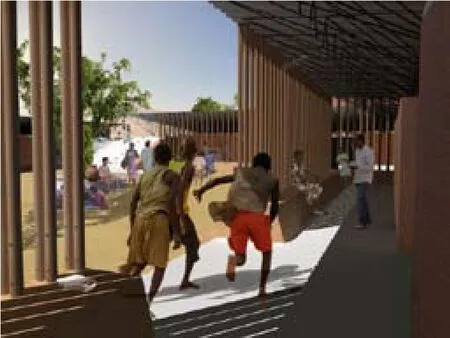
9 缓冲区域/Buffer zone
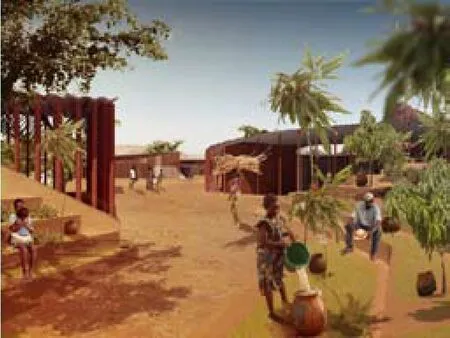
10 庭院/Courtyard
